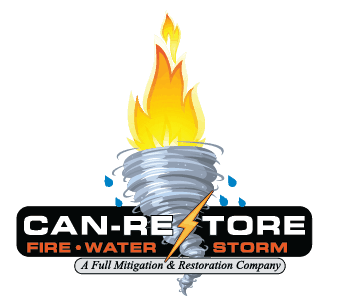Water damage clean up and your sanity don’t have to make a good match.

What Water Damage Can Really Do
Although 71% of the earth is made up of water, we want something closer to 0% in our homes. Water is necessary to life, but incredibly destructive to homes and structures, especially if we’re talking about excess water from storm damage. The truth is that water in your home, weather it’s from a natural disaster that has caused flash flooding to sweep through your house, overflowing gutters that caused a flooded attic, or a cracked foundation during torrential rains that allowed water to fill your basement, can cause an enormous amount of damage. Everything from structural damage to damaged flooring, appliances, and furniture can result from all that excess moisture in your house.
The Real Dangers of Mold
Mold is one of the worst after-affects of storm damage. Mold can begin to grow in less than 24 hours if water is left untreated. When there’s a storm and water gets into your home, it’s not always possible to get it out and treated within 24 hours, so mold is not only a potential problem, but a probability.
Mold will cause damage to the structure of your home, often making it necessary to replace wood support structures, drywall, and flooring, but it also poses a real health risk. Exposure to mold can cause symptoms that include nasal congestion, runny nose, itchy eyes, chest congestion, skin rashes and reactions, headaches, fatigue, and even respiratory inflammation and distress. Avoiding mold is one of the top priorities when dealing with water damage.
The Truth about Water Damage Restoration
Water damage restoration is a specific process that takes time and expertise, but it doesn’t have to be the nightmare everyone imagines. Unless you try to do it yourself. The importance of proper water damage treatment cannot be overstated. No matter how handy and resourceful you might be, it’s critical to leave water restoration to the experts. Here’s why:
- Water extraction needs to be done as quickly as possible by a company that offers emergency response. The sooner water can be extracted the more likely you can prevent further or even permanent damage to your home.
- Water extraction is just the beginning. Removing the water completely using extraction equipment is the critical first step, but there’s more to it. Complete drying is essential to recovery. Using industrial fans and specialty flooring, cabinet, and wall cavity drying equipment followed by dehumidifiers and ozone generators, it’s possible to completely remove the excess moisture from the areas affected to make sure further damage isn’t done and to halt any additional mold growth or spread. This includes drying of the structure, flooring, carpeting, upholstery, appliances, and personal property.
- Mold removal and mitigation follows the drying process. Proper removal techniques are vital to prevent the spread of mold throughout the home and to protect the individuals performing the removal.
- Restoration is the next step in the process. Repairing the home, the furniture, and all of the personal belongings is what will allow you to return to a home that is in living condition.
Dealing with damage from a storm is no picnic, but if you understand all that goes along with the risks and the restoration process, you can keep it from being a total nightmare. To keep your sanity in tact while dealing with storm damage, call in the professionals to get you through the challenges that go with water damage.
Contact Can-Restore for help with water damage clean up by calling (770) 735-2695 or by clicking here.

